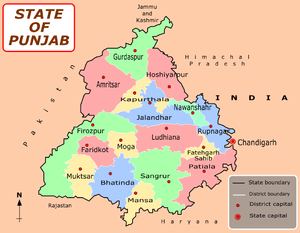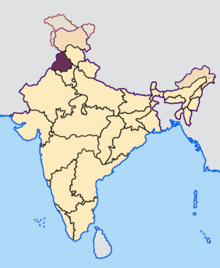Faridkot, Punjab
| Faridkot ਫ਼ਰੀਦਕੋਟ | |
|---|---|
| D | |
 | |
 Faridkot  Faridkot | |
| Coordinates: 30°24′N 74°27′E / 30.40°N 74.45°ECoordinates: 30°24′N 74°27′E / 30.40°N 74.45°E | |
| Country | India |
| State | Punjab |
| District | Faridkot |
| Founded by | Raja Mokalsi |
| Named for | Baba Farid |
| Government | |
| • Type | Municipal Council |
| • Deputy Commissioner | Malwinder Singh Jaggi , IAS |
| Area | |
| • Total | 18.14 km2 (7.00 sq mi) |
| Elevation | 196 m (643 ft) |
| Population (2011) | |
| • Total | 6,17,508 |
| Demonym(s) | Faridkotian, Faridkotiya |
| Languages | |
| • Official | Punjabi |
| Time zone | IST (UTC+5:30) |
| PIN | 151203 |
| Telephone code | +91-1639 |
| Vehicle registration | PB-04 |
| Sex ratio | 1000/890 ♂/♀ |
| Literacy | 72% |
| Website |
www |
Faridkot (Punjabi: ) is one of the 22 districts in the state of Punjab, India with Faridkot city as the district headquarters. Faridkot District was a part of the erstwhile Ferozepur Division but in the year 1996, Faridkot Division was established with a Divisional headquarter at Faridkot which includes Faridkot, Bathinda and Mansa districts.
Etymology
The district is named after its headquarters, Faridkot city, which in turn is named in the honor of Baba Farid, who was a Sufi saint and a Muslim missionary. The town of Faridkot was founded during the 13th century as Mokalhar by Raja Mokalsi, the grandson of Rai Munj, a Bhatti Chief of Bhatnair, Rajasthan. According to a popular folklore, the Raja renamed Mokalhar to Faridkot after Baba Farid paid a visit to the town. It remained the capital during the reign of Mokalsi’s son Jairsi and Wairsi.
History
Prior to independence, a large part of the district was under the rule of the Maharaja of Faridkot and later it became a part of the Patiala & East Punjab States Union (PEPSU) in 1948. Faridkot was carved out as a separate district on 7 August 1972 out of the areas of erstwhile Bathinda District (Faridkot Tehsil) and Ferozepur District (Moga and Muktsar Tehsils). Further, in November 1995 the Faridkot District was trifurcated when two of its sub divisions viz. Muktsar and Moga were given the status of independent districts.
Government body
The Municipal Council Faridkot came into existence in the year 1948 and now has a Class -I status. Uma Grover is the current President of the council.
Geography
The average elevation is 196 metres (643 ft). The town is located on the Punjab Plains, which in a macro regional context forms a part of greater Satluj Ganga plain. It is a low-lying flat area. The surface of the district is depositional plain which was formed by alleviation by the rivers flowing in these plains. Sirhind feeder and Indira Gandhi Canal passes through the district. The topography of the district is plain, with only 1.4% of its area under forest cover.
 |
Firozpur district |  | ||
| |
Moga district | |||
| ||||
| | ||||
| Muktsar district | Bathinda district |
Demographics
As of 2011 India census,[1] Faridkot had a population of 618,008 which constitute about 2% of the total population of Punjab. Males constitute 327,121 of the population and females 290,887.The population density in this district is 424 persons per km2. Faridkot has an average literacy rate of 70.6%: male literacy is 75.9%, and female literacy is 64.8%.
Climate
The climate of the Faridkot is mostly dry, characterized by a very hot summer, a short rainy season and a bracing winter. The cold season is from November to March. it is followed by the summer season which lasts up to the end of June. The period from July to the middle of September constitutes the southwest monsoon season. The later half of September and October is the post-monsoon or transition period. The temperature increases rapidly beginning with the end of March till June, which is the hottest month, with the mean daily minimum temperature about 41 °C and the mean daily minimum about 26.5 °C. The temperature is intensively hot during this period. The maximum temperature can go beyond 47 °C on some days. With the onset of the monsoon by the end of June or early July, there is an appreciable drop in the day temperature. After October, both the day and night temperatures decrease rapidly till January which is the coldest month. The mean daily maximum temperature in January is about 20 °C and the mean daily minimum about 4.5 °C.
The average annual rainfall in the district is 433mm; about 71 percent of the annual rainfall in the district is received during the monsoon months July to September. Some rainfall occurs during the pre-monsoon months, mostly in the form of thundershowers. Weather is moderately cloudy during the monsoon season. During the rest of the year the skies are mostly clear. Wind speed is normally slow and flows in north to northwest, some times in southeast direction, throughout the year.
Festival (Aagman Purab)
Ever year, a festival is held to commemorate the arrival of Baba Farid in Faridkot. The festival is held for 3 days every year from 21 September - 23 September. On 23rd September, a grand parade departs from Tilla Baba Farid (Sikh Temple) and reaches Godari Sahib (Sikh Temple).
Religious Places
- Gurdwara Tilla (Chilla) Baba Farid
This temple is as old as the town itself. This temple is situated near Qilla Mubarak (Royal Fort). Baba Farid remained at this place in meditation for 40 days before proceeding to Pakpattan. A sacred piece of wood with which Sheikh Baba Farid wiped his hands littered with mud has been preserved in this temple. Shabad-Kirtan (Sikh hymns) are recited daily and Langer (community kitchen) is also served every day to the people visiting the temple.
- Gurdwara Godari Sahib
This place is situated on the outskirts about 4 km on Faridkot-Kotkapura road. It is believed that Baba Sheikh Farid left his godari (jacket) there before entering Faridkot town. A gurdwara had been constructed in 1982 and a sarover (pond) was later constructed at this place.
Education
The city houses Baba Farid University of Health Sciences, which is the premier medical university of Punjab. Guru Gobind Singh Medical College and Hospital was established in the year 1973. Dasmesh Institute of Research & Dental Sciences is another medical school in the city. Brijindra College was set-up in 1942 by the Faridkot Royalty. Dasmesh Public School, Baba Farid Public School, St. Mary's Convent School and Delhi International School,Balvir school are prominent schools in the town besides several other educational institutes.
Hospitals
- Guru Gobind Singh Medical College, Faidkot
- Sant Baba Karnail Dass Medical Charitable Hospital, Vivek Ashram
References
- ↑ "Census of India 2001: Data from the 2001 Census, including cities, villages and towns (Provisional)". Census Commission of India. Archived from the original on 2004-06-16. Retrieved 2008-11-01.
External links
| Wikivoyage has a travel guide for Faridkot. |
